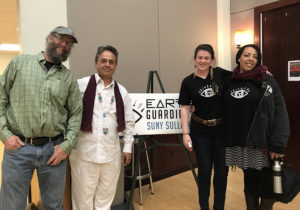by Eli Ruiz
LOCH SHELDRAKE –Through a chance encounter at a recent anti-pipeline rally, a 17-year-old SUNY Sullivan student was able to convince an Oscar-nominated documentarian to bring his latest work to the Loch Sheldrake campus for an intimate screening of “Gathering Our Hearts at Standing Rock,” just in time for Earth Day.
Iris Fen Gillingham, a first-year early admission student from Livingston Manor, has had a front row seat to climate change her whole life—three major floods, which should have been 100- and 500-year events, hit her family farm within a span of five years when she was a child. As a result, her family was unable to keep farming for a living. Add to that the looming threat of fracking, and Ms. Gillingham knew she had to add her voice to the climate change fight. She is regional youth director for Earth Guardians New York, and she is involved in SUNY Sullivan’s branch of Earth Guardians RYSE (Rising Youth for a Sustainable Earth).
“Seeing the state of the world today I realized that if I want to have a future, a future where myself and my kids will have clean drinking water that I could not wait for political leaders to evoke change,” Ms. Gillingham said. “We as the people have the power to create a sustainable and just world. I cannot just accept the status quo, and as a young person I am going to use my voice to speak and my feet to march.”

On April 19, director Fidel Moreno brought his film, “Gathering Our Hearts at Standing Rock” to SUNY Sullivan’s Seelig Theatre at the request of Ms. Gillingham and a friend. After the screening, Mr. Moreno answered questions from the audience and performed a traditional water ceremony in honor of the water protectors at Standing Rock.
The documentary was filmed at the Standing Rock Sioux Reservation in North Dakota, during the height of protests against the Dakota Access Pipeline, which would carry oil through Sioux ancestral lands and threaten the tribal water supply. Many people still don’t understand the whole story of Standing Rock, Mr. Moreno said before the screening, and he hopes his film will help provide that information. The issue is not over, despite President Donald Trump lifting delays on the pipeline, Mr. Moreno said, and he plans to visit Standing Rock again.
“One of the things that struck me when we arrived was how absolutely everyone was working together toward this common goal: protecting their water and land,” Mr. Moreno said of his experience at Standing Rock. “So many people coming and going but still there was order… at one point there were over 280 distinct tribes from all over the U.S., Central and South America, and Canada. It truly made me realize the power of numbers, that a likeminded group can really get things done.”
It’s important to connect North Dakota to New York, Ms. Gillingham said, so local residents understand the significance of the situation.
“One of the biggest issues with climate change is that the oil and gas industry is in a rush to build the infrastructure to keep us addicted for the next 50 years” Ms. Gillingham said. “The oil industry’s attempt to increase oil tanker and barge traffic along the Hudson, build two pipelines from Albany to refineries in New Jersey, and increase oil traffic by rail, including crude from the tar sands, will take us down the wrong road. One that is dependent on fossil fuels.”
